博文
Prospect of Internet, Brain Science and Human
||
说明:这篇论文发表在《复杂性与智能化》期刊2014年第38期上(2014.8.1),较为系统的阐述了我们在互联网进化方向,互联网与脑科学的最新研究成果。一下内容为该论文的英文翻译版本。
Note: This article was published in the "Journal of complexity and intelligence" in 2014 thirty-eighth period(2014.8.1), expounds the Internet evolution
direction, the latest research results of the Internet and brain science.
Introduction of authors:
Liu Feng, male, Dr. M (on-job) at School of Computer and Information Technology,
Email: zkyliufeng@126.com; Research Areas: Interdisciplinary study of the Internet and the brain science, and study of Internet IQ and artificial intelligence.
Shi Yong, male, researcher and executive vice president at CAS Research Center on Virtual Economy & Data Science; Email: yshi@ucas.ac.cn; Research Areas: data mining and intelligent knowledge management
Abstract: in this paper, the author describes the latest developments and achievements of the comparative study on the Internet and the brain science from five aspects. Firstly, the author introduces the origin and progress of the comparative study on the Internet and the brain science; and then, analyzes the relationship between the Internet of Things, cloud computing and big data in view of the brain science; points out the important instructive significance of the development of the Internet, as a control study, to the brain science; raises the issue of IQ of the Internet and search engines on the basis that both the Internet and the brain have intellectual characteristics; ranks the IQs of 50 major search engines across the world, and finally deduces the prospect of the Internet and the human being, and accordingly proposes that the universe, the brain and the Internet will be evolved to be integrated into the universe brain or the intelligent universe.
I. Technological Revolution and Scientific Breakthroughs
Every major technological change in the human society will lead to a scientific revolution in a new area. The biological diversity and the influence of isolated ecosystems on organisms were witnessed by human beings in the Uncharted Waters. However, Either Darwin or Wallace found the biological evolution phenomenon by following the fleet in voyage.
Large Industrial Revolution enabled human had a great improvement either in the use of power or observation ability and had technologically supported major physics breakthrough starting 100 years later, such as Newton's Universal Gravitation, Einstein's Theory of Relativity and the quantum mechanics building created by many scientists. All of these breakthroughs relate to the "force" and "observation".
The influence of the Internet revolution on human beings has far exceeded that of the Great Industrial Revolution. Different from the Industrial Revolution which enhanced the human strength and extended their vision, the Internet greatly has promoted human intelligence, enriched human’s knowledge, while intelligence and knowledge are just the factors the most closed to the brain.
II. Interdisciplinary comparison Study on the Internet and the Brain Science
If we observe new applications and features of the Internet appearing in the recent about 20 years carefully, it can be intuitively found that the Internet and brain structures have more and more similarities, including: the remote operation and control of printers and copiers, surgeries remotely carried out on line by doctors; Chinese water conservancy departments placing sensors in the soil, rivers and air, and the air temperature, humidity, wind speed and other data transmitted to the information processing center timely through the Internet, forming a report for making the decision about flood control and drought resistance; Google has launched the "Street View" service
and installed many multi-lens cameras in cities, so that Internet users could watch townscapes of Denver,
Las Vegas, Miami, New York and San Francisco and so on in real time.
These new Internet phenomena respectively show the rudiment of the motor nervous system, the somatosensory nervous system, and the visual nervous system. Based on the new Internet phenomena mentioned above, we published a paper with the title of Discovery and Analysis on the Law of the Internet Evolution Pattern in September 2008, in which we analyzed the mature structure from a neurological point of view; And the structure was imagined as an organic structure highly similar to the structure of human brain - Internet virtual brain where we can identify and locate the virtual auditory, visual, sensory, motor and central nervous systems of the Internet and thus draw a structure diagram of the Internet virtual brain as indicated in Fig. 1.
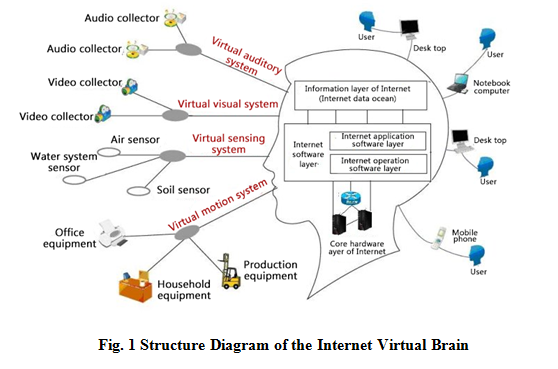
At the same time, we also proposed the important inspiration of the brain science to the future development
of the Internet accordingly. Then, will the ever-being
evolving Internet structure and its functions become the key to the secret of the brain? That means, the human brain had contained the Internet architecture to be or have been well established nowadays or in future since tens of thousands of years ago, and can we through a neurophysiological and neuropsychological research test find a search engine like Google, a SNS system like Facebook, an address coding system like IPv4 and a routing system like Cisco in the human brain?
The possibilities of interdiscipline comparison between Internet and neurology has been proved with the development of sciences afterwards. On June 10, 2010, Larry • Swanson and Richard Thompson, neuroscientists from the University of Southern California published the paper titled Hypothesis-driven
Structural Connectivity Analysis Supports Network Over Hierarchical Model of Brain Architecture in PNAS of the United States, where they pointed out that there was a small area similar to the Internet structure in rats. Larry • Swanson’s studies indicate that the presence of the Internet structure in the brain may explain the phenomenon that local damage can be overcome in brain as if any individual part of the Internet may be removed while the remains can work normally as usual, and the nervous system is not absolutely indispensable to a certain part. This study proved that connectivity of the Internet and the nervous system from the neurology and neurological points of view.
On November 16, 2012, Dmitri Krioukov from University of California, San Diego published a paper titled Network Cosmology in Scientific Report, where he also proposed that the development of the Internet and the brain neural network highly similar with each other. Through the use of computer simulation, combined with other calculations, the research team proved that the curve chart showing the
cause-and-effect relationship network of the large-scale space-time
structure in the dynamic development and control of complex networks, was a power function curve with significant clustering features, and had a high similarity with many complex networks such as the Internet, social networks, neural networks, etc. Dmitri Krioukov’s research provided a strong statistical support for the assumption of Internet virtual brain.
III. Relationship among the Internet of Things, Cloud Computing, Big Data and the Internet to be analyzed in View of Brain Science
First of all, the Internet of Things highlights the concept of sensor perception. Besides, it also has functions of network line transmission, information storage and processing and industrial applications interface. Furthermore, it often shares servers with the Internet, network cabling and application interface, so that the communication of Human to Human (H2H), Human to Thing (H2T) and Thing to Thing (T2T) becomes possible, and the human society, the information space and the physical world (human, machine and things) will ultimately be integrated. According to the difference and the correlation between the Internet of things and the Internet, we made indications on the structure diagram of the Internet virtual brain, as shown in Figure 2.
With a comprehensive survey on the concepts and practical applications of cloud computing, we can find out two characteristics of cloud computing: firstly, the basic service source of the Internet, such as server hardware, software, data and application services, began with the centralization and unification; and secondly, the Internet users do not have to repeatedly consume a lot of resources to establish independent software and hardware facilities, organize maintenance staff forces and they can meet their own requirements by receiving services provided by cloud computing service providers online.
In the architecture of the Internet virtual brain, the central nervous system of the Internet virtual brain provides support and services to all the virtual nervous systems of the Internet by integrating the core hardware layer, the core software layer and the information layer of the Internet. Viewing from the definition, the features of cloud computing and those of the central nervous system of the Internet virtual brain fit with each other very well. Ideally, the sensor of the Internet of Things and the user of the Internet achieve interaction with cloud computing through the network line and computer terminals, provide data to cloud computing and accept the services provided by cloud computing. Based on the above analysis, we marked the positions of cloud computing in Figure 2 as follows.
With the rise of technologies like blogs, social networks, cloud computing, and Internet of Things, the data on the Internet is constantly growing and accumulated at an unprecedented rate. Due to the interaction of Internet users, information dissemination of businesses and government, the real-time
information sensed by the sensors of the Internet of Things is producing plenty of structured and non-structured
data all the time. All the data is distributed throughout the network system in a enormous amount, which involves very valuable information covering economy, science and technology, education, and so on.
When defining the information layer of the Internet virtual brain in our paper titled Interdisciplinarys Comparative Study of the Internet and Neurology, we described “the Internet information is growing at an explosive rate, the forms of the information includes text, two-dimensional
images, documents, videos, voice, three-dimensional images,
etc., which widely distribute in servers, routers, switches, user terminals and the virtual nervous system of the Internet. The information distributed online is referred to as the information layer or data ocean of the Internet virtual brain”.
It is foreseeable that big data will gradually form the information layer (data ocean) of the Internet virtual brain when the capacity for big data further increases and the storage form tends to further concentrate. Therefore, we marked large data in Fig. 2 below.
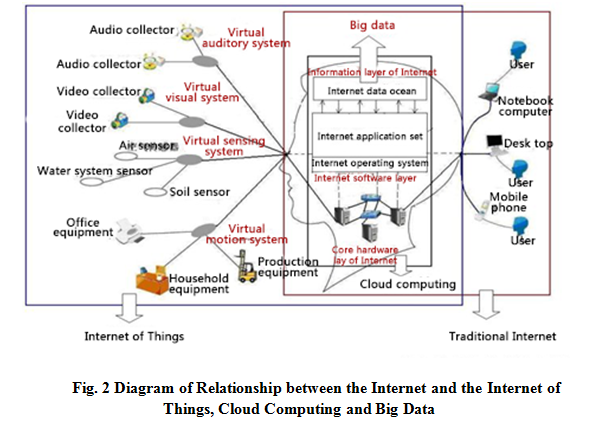
On the basis of the structure diagram of the Internet virtual brain, we analyzed the relationships between the Internet of Things and the Internet, as well as between cloud computing and big data, and marked the positions of the Internet of Things, cloud computing, big data and traditional Internet in the structure diagram of the Internet virtual brain and it also indicates that that the Internet virtual brain architecture based on neurology can effectively unify new applications and concepts generated in the development of the Internet.
Next, we can use more neurological knowledge to analyze operating modes and development trends of the Internet, the Internet of Things, cloud computing, and big data. The areas worthy of being studied include: is it possible to use the neural reflex arc principles to analyze the interaction mode between the Internet of Things and cloud computing, and is it possible to use the neuron structure to analyze the combination trend of the social networking and the Internet of Things.
IV. Inspirations of the Internet Development on the Study of Brain Science
When the view that the Internet is evolving towards the direction of highly similar to the human brain structure was proposed, the questions “is it possible that the structureof the human brain will, in turn, be also highly similar to the interne?” and “is it possible that the human brain also has the routing system, search engine, IPv4 / IPv6 address coding system, Wikipedia and the SNS system the same as Facebook” followed. If the conjecture is true, then the secret of brain will be solved step by step in front of the Internet by comparing the structure of the Internet and that of the human brain.
Historically, neuroscientists studied the secret of the brain mainly through two distinct ideas: reductionism and holism. The reductionism is also known as a bottom-up
research method. With this method, we try to understand the neverous system by studying the properties of base elements of a single molecule, cell, or loops.The holism is also known as a top-down
research method, with which wemainly starts from the research of function to understand the nervous system. The method is mainly concerned with how to adjust the system activities or make it reflected in behaviors.
As early as in the late 20th century, Professor Callahan, an American biologist proposed the concept of Reverse Bionics. He believes that some mysteries of nature may be explained through careful study on the objects designed and manufactured by human. From abacus to computer, and, from car to spacecraft, many of human’ inventions and designs are not the products by directly imitation of some natural phenomena, but following certain laws of nature. Meanwhile, many superb skills of living beings are not supernatural products, and they follow laws of nature as well. The similarity between the two is the results under common laws of nature, which can be described as Different Roads Lead to the Same Destination.
It can be regarded as an idea of inverse bionics to analyze the secret of human brain by taking function and struction of inernetnamely to the technology, structure, business model characteristics of the Internet to form the experimental method for brain research, and carry out scientific experiments continuously to gradually promote the development of brain science in the 21st century.
On March 24, 2011, we completed the test about whether there was a search engine in the human brain in the Internet open class of the Graduate School of Chinese Academy of Sciences. In the class, we carried out the test together with nearly 50 graduate students coming from various institutions. The test procedures and results were included in the book Theory of Internet Evolution published in 2012.
In this book, we had a further discussion about whether there was a hierarchical system similar to Twitter, Wikipedia and IPv4 / IPv6 in the human brain.
The research in this area has begun to make progress in other countries. In 2011, through a US study, it was found that the nervous system in a small area of the rat brain was similar to the routing-like
functional structure of the Internet. This challenged the traditional theory that the nervous system of the brain is of a hierarchical structure. These study results were published in Proceedings of the National Academy of Sciences in June 2011.
Generally, the Internet and the human brain may be highly complementary to each other in the reasearch area, that is, with the known structure of the human brain, we can predict the development trend of the Internet in the next step. Besides, the known characteristics of the Internet may be used to explain the secret of human brain, as shown in Table 1.
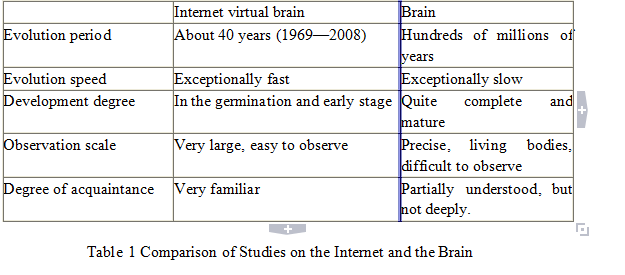
V. IQs of the Internet and Search Engines
As previously mentioned, more and more signs show that the Internet has a high similarity with the brain in structure and function. The presence of intelligence is the most important feature of the brain. The test on the intelligence is namely the basis for generation of the human intelligence. Since the Internet is similar to the brain, whether the Internet or its subsystems are intelligent or whether the test on them may form the intelligence of the Internet, is a noteworthy research area.
The development of the Internet intelligence is far from perfect, so human IQ tests cannot be fully applied to the Internet. Almost no Internet subsystem is able to complete the operation ability tests for measurement of human intelligence. Therefore, we need to define the Internet and Internet subsystem IQs by making use of advantages of the abovementioned intelligence scale, and design a new intelligence assessment system along with the establishment of test question bank, so that they ccould be used to test the Internet application systems and different ages of human. According to the test results therein, we will be able to see the gap between the Internet and human intelligences quantitatively. Besides, it will be possible to find the changes in the gap between the Internet and human intelligences through timed tests.
Based on the basic understanding that “The intelligence is the ability of people to understand objective things and solve practical problems via the use of knowledge”, a new IQ evaluation system general for machine and human was established from the aspects of acquisition ability (observation), knowledge-mastering
ability, knowledge innovation ability and knowledge feedback ability(expression ability ) , and 15
sub-tests were set based on the consideration of these four aspects, and make the weight
using the Delphi method.
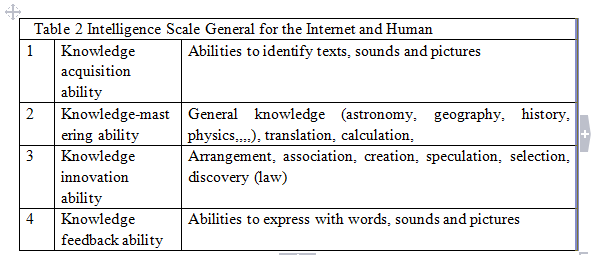
There are many types of Internet applications further focusing the search engine. As one of the most important current applications of the Internet, the search engine representatives include Google, Baidu, Bing, etc. The intelligence level of these search engines are continuously being improved in a variety of ways. Therefore, it is typically significant to choose the search engine for IQ tests and compare the test results with those results of human.
According to the Intelligence Scale commonly applicable to the Internet and human, an IQ test question bank general for the Internet and human may be established. In May, 2014, we used this test bank (due to space limitation, no detailed introduction is provided here) to carry out the tests on more than 50 search engines and 3 different age groups, and the test results are shown in Table 4
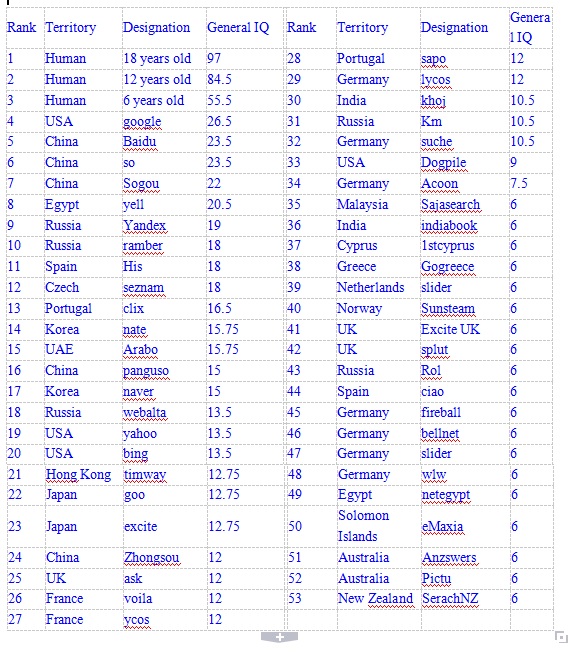 Table 3 Table of IQ test results commonly applicable to human and search engines
Table 3 Table of IQ test results commonly applicable to human and search engines
According to the test results, we found that search engines are superior to human in terms of the knowledge mastering abilities, but as for the knowledge creation ability, their intelligences were scored as zero. The knowledge creation ability had a higher weight in the M&H IQ test, so the overall intelligence of search engines across the world was much lower than human intelligence. And even the intelligence of Google which had the highest IQ value, did not reach half of that of a six-year-old child.
Overall, search engines have a higher ability in the general knowlege, translation and calculation areas, but a lower ability in knowledge acquisition and feedback, especially in the areas in relations to higher wisdom like arrangement, association, creation, speculation, selection and laws discovery, etc., their ability are essentially zero. There is a large difference compared to those abilities of human, and the IQs of search engines need to be improved in the future. The preliminary study results have been published in the second session of ITQM held in Moscow on June 6, 2014, the title of the paper was The Search Engine IQ Test based on the Internet IQ Evaluation Algorithm.
VI. Evolution of the Internet and Future of Human
Darwin's Theory of Evolution has an important view that the biological evolution is not just evolving from a lower level to a higher level, and human beings are not more advanced than other organisms. He imagined the process of biological evolution as a tree growing while branching. Any of existing organisms is located at the top of a small tree branch, and it is difficult to say which is more advanced and it is also meaningless to have a low or high level comparison among coexisting species. Evolution is not predetermined, and there is not a trunk with human as the top in the evolution tree and just a branch of the tree.
John. C. Eccles, an Australian scientist and a Nobel Prize Winner, mentioned in his book titled Brain Evolution, that “the evolution of the brain is evolving from a fish's brain to a reptilian brain, and then to a mammalian brain, and finally to a human brain. If a human brain is dissected, we can clearly see the fish-like, reptile-like and mammal-like structures are respectively very clear in the human brain. "
Although biological patterns are various, their core - brain indeed shows a remarkable directionality. From single cell to human, the brain is becoming more and more complex with increasing wisdom. After have reached the highest point-human brain, the biological evolution shows a new form. The human is under the co-evolution with the Internet. The result of this co-evolution is,
the Internet connecting with human, is becoming highly similar with the brain structure, and continues spreading to the outer space with the extension of human. If having enough time, we can anticipate that the universe, brain and Internet will be integrated at an infinite time point, evolving into the universe brain or the intelligent universe.
The conclusion of Darwin’s Theory of Evolution is derived forward, namely, the organisms have a common ancestor, and then human appeared through natural selection, while the conclusion of the theory of the Internet is derived backward, in which, it is thought that human evolves to the universe brain or intelligent universe via technologies and tool-Internet created by themselves. Human,
is a key factor connecting the Internet evolution and biological evolution. We can see a new evolution chain, as shown in Fig. 3.
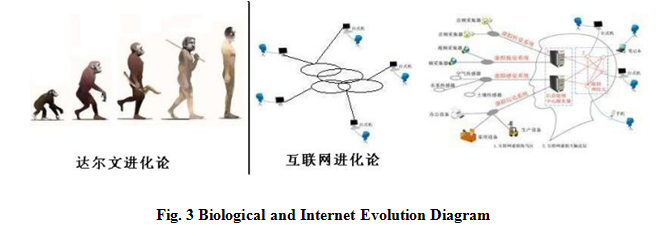
https://blog.sciencenet.cn/blog-39263-866827.html
上一篇:图解互联网左右大脑组织结构图
下一篇:大脑中存在互联网应用获得强有力印证